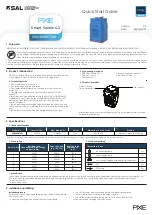
the relative humidity is low, not only affecting the use life of the equipment, but also causing communication faults. The
following table shows the requirements for the dust content and granularity in the equipment room.
Substance
Concentration Limit (particles/m
3
)
Dust particles (diameter
≥
0.5
μ
m)
≤
3.5
×
10
6
Dust particles (diameter
≥
5
μ
m)
≤
3
×
10
4
The air filter of the RG-S12006/S12010 must be cleaned at interval to ensure good ventilation and dust
prevention.
Apart from dust, the salt, acid and sulfide in the air in the equipment room must also meet strict requirements; as such
poisonous substances may accelerate the corrosion of the metal and the aging of some parts. The equipment room
should be protected from the intrusion of harmful gases (for example, SO
2
, H
2
S, NO
2
and Cl
2
), whose requirements are
listed in the following table.
Gas
Average (mg/m
3
)
Maximum (mg/m
3
)
SO
2
0.3 1.0
H
2
S 0.1 0.5
NO
2
0.5 1.
0
Cl
2
0.1 0.3
The
Average
refers to the average limit of harmful gas in one week. The
Maximum
value is the upper limit of
the harmful gas measured in one week for up to 30 minutes every day.
Dusting Cycle Suggestions:
1. Clean the air filters every three months.
2. Dust the air intakes and exhaust vents of all modules every three months.
3. Dust the modules every one or two years.
4. Dust the fan shelves yearly.
5. Dust the chassis, including the backboard, every one or two years.
If the device is in a poor dust prevention environment, please increase the dusting times.
Power Requirements
When the RG-S12000 uses the AC power supply:
RG-PA1200I: AC input voltage: 90–264V~, 47~63Hz
RG-PA2000I: AC input voltage: 90–264V~, 47~63Hz
Ac input power shall be larger than the actual power consumption of entire system. For example, the S12010
chassis is installed with two M12000-CM III modules, three M12000-48XS-DA modules, three
















































